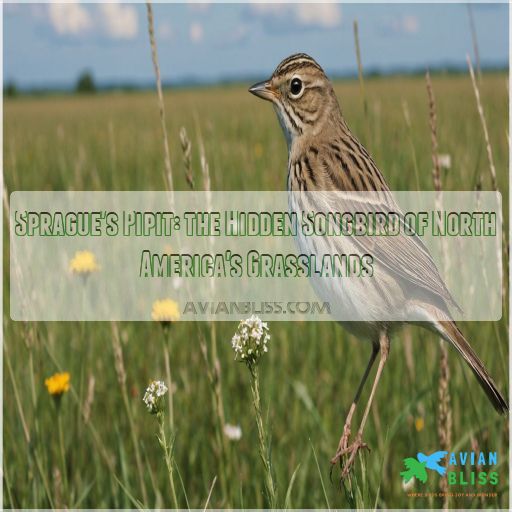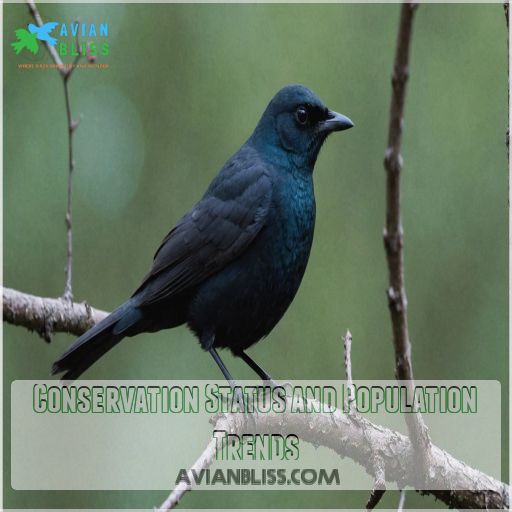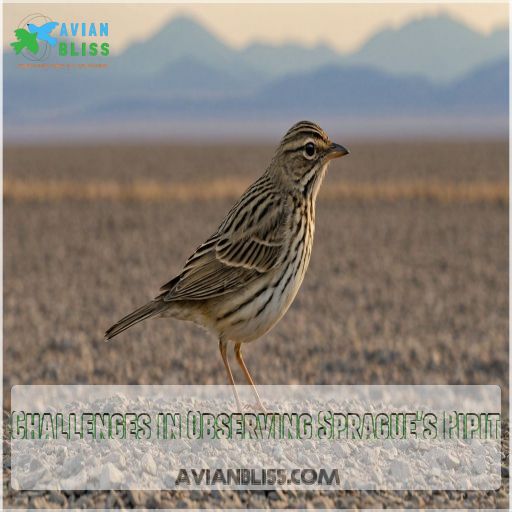This site is supported by our readers. We may earn a commission, at no cost to you, if you purchase through links.

But don’t let its shy nature fool you – the Sprague’s pipit puts on quite a show during Breeding season. Males soar up to 300 feet high, hovering and singing for hours to woo potential mates.
It’s like watching a tiny airplane perform aerial acrobatics like the black-legged kittiwake’s flight
! These grassland specialists face challenges due to habitat loss, making sightings a rare treat for birdwatchers.
If you’re patient and lucky, you might just catch a glimpse of this elusive performer’s sky-high serenade.
Table Of Contents
- Key Takeaways
- Sprague’s Pipit: a Grassland Songbird
- Distinctive Features of Sprague’s Pipit
- Breeding Habits and Nesting Behavior
- Migration Patterns and Seasonal Movements
- Diet and Foraging Techniques
- Conservation Status and Population Trends
- Challenges in Observing Sprague’s Pipit
- Frequently Asked Questions (FAQs)
- Why is Sprague’s pipit so difficult to find?
- Where did Sprague’s pipit come from?
- How do you know if a Sprague’s pipit is a bird?
- Why are Sprague’s pipits endangered?
- Is the sprague’s pipit endangered?
- What is the difference between American pipit and Sprague’s pipit?
- What are some interesting facts about Sprague’s pipit?
- Is a pipit a sparrow?
- What is the typical lifespan of a Spragues Pipit?
- How do Spragues Pipits communicate with each other?
- What are the main predators of Spragues Pipits?
- Do Spragues Pipits form flocks outside breeding season?
- How do climate changes affect Spragues Pipit populations?
- Conclusion
Key Takeaways
- Spotting a Sprague’s Pipit in the wild is like playing "hide and seek" with nature—these grassland birds are camouflage experts. Their buffy-brown plumage blends seamlessly into their native prairie homes, making them tricky to find, but patience can reward you with the sight of their mesmerizing aerial displays.
- These introverted pipits are the ultimate sky performers, known for their jaw-dropping aerial courtship rituals. Picture tiny airplanes performing acrobatics as males soar high, singing their songs from the sky—a show worthy of setting your binoculars on them.
- Sprague’s Pipits are picky about their homes, preferring native prairies with the right mix of grasses and vegetation. However, their real estate is shrinking due to habitat loss—it’s a dire reminder of how precious these open grasslands and wetlands are to both pipits and birdwatchers alike
.
- Climate change, habitat loss, and agriculture are major threats to these little songbirds. It’s up to you, as their unofficial ambassador, to appreciate their song flights and support conservation efforts that protect their prairies, ensuring that future generations can witness the Sprague’s Pipit’s aerial serenades.
Sprague’s Pipit: a Grassland Songbird
You’re about to meet one of North America’s most elusive songbirds, the Sprague’s Pipit.
This grassland-dwelling bird mightn’t catch your eye at first glance, but its unique behaviors and adaptations make it a fascinating subject for bird enthusiasts and conservationists alike, especially when considering Burrowing Owl Habitats
.
Physical Characteristics and Identification
You might find yourself squinting out across the prairie, trying to spot a Sprague’s Pipit. This elusive grassland songbird is a master of camouflage, with its buffy-brown plumage blending seamlessly into its surroundings.
But keep your eyes peeled for its distinctive field marks: a pale, slender body about 6.5 inches long, white outer tail feathers, and a thin bill (Source).
It’s like playing "Where’s Waldo?" in the grasslands, searching for this bird with its buffy-brown plumage.
Habitat Preferences and Range
Few grassland birds are as picky about their real estate as the Sprague’s Pipit. This elusive songbird calls native prairies home, preferring:
- Intermediate grass height
- Sparse to moderate vegetation density
- Low forb density and minimal bare ground
You’ll find these habitat specialists breeding in Montana, North Dakota, and central Canada . Their restricted range, coupled with widespread habitat loss, has led to concerning population declines.
Winter months see them venturing south to warmer grasslands, dodging the prairie’s harsh chill.
Unique Behaviors and Adaptations
Sprague’s Pipit isn’t just another pretty face in the grasslands. This clever bird has a few tricks up its feathered sleeve!
Its most impressive party trick? An aerial breeding display that’ll make your jaw drop.
Imagine this: soaring up to 300 feet high, then hovering and circling for minutes on end while belting out its signature tune.
Talk about putting on a show!
Historical Discovery and Naming
The elusive Sprague’s Pipit owes its name to Isaac Sprague, a talented botanical illustrator who joined John James Audubon’s 1843 Missouri River expedition.
While Sprague hoped for recognition, Audubon unfortunately left his contributions largely uncredited.
This unassuming grassland bird, discovered during the expedition, carries Sprague’s legacy in its scientific name, Anthus spragueii . It’s a bittersweet reminder of the complex relationships in early North American ornithology.
It also serves as a tribute to the often-overlooked contributions of those who supported the work of famous naturalists like John James Audubon.
Distinctive Features of Sprague’s Pipit
You’ll need a keen eye to spot the elusive Sprague’s Pipit, but its unique features make it worth the effort.
From its streaked plumage to its thin bill and distinctive tail markings, this grassland bird has several telltale signs that set it apart from its look-alikes.
Plumage Coloration and Patterns
Have you ever tried spotting a Sprague’s Pipit in its natural habitat? You’ll need a keen eye, as their plumage is a masterclass in grassland mimicry.
These birds sport a rich, light brown coloration with buffy edges on their feathers, perfect for blending into their prairie home .
Seasonal changes and age can affect their appearance, with hatch-year birds showing broader buffy borders compared to adults. Their camouflage is so effective, you might walk right past one without noticing, thanks to their natural habitat!
Bill Shape and Size
You’ll find the Sprague’s Pipit’s bill quite distinctive. It’s short and thin, perfect for its insect-heavy diet . This little songbird’s bill shape has evolved to suit its feeding habits in grasslands.
When you’re out birdwatching, keep an eye out for:
- A slender, needle-like bill
- A slightly curved culmen (upper ridge)
- Pale pink to pinkish-orange coloration
- A blunt tip, unlike other pipit species
The bill’s design is nature’s Swiss Army knife for these grassland dwellers!
Tail Feather Markings
Shifting our gaze from the pipit’s bill, let’s ruffle some feathers – tail feathers, that is.
You’ll find Sprague’s Pipit’s tail is more than just a rudder for flight.
It’s a calling card, with extensive white on the outer tail feathers that’ll catch your eye.
This distinctive feature isn’t just for show; it’s a key identification aid when these grassland ninjas take to the sky.
Comparison to Similar Species
While the Sprague’s Pipit’s white outer tail feathers are distinctive in flight, you’ll need to sharpen your ID skills to distinguish it from look-alikes on the ground.
Don’t mistake it for a Vesper Sparrow – the pipit’s thin bill is a dead giveaway . It’s also not an American Pipit, which has a streakier back.
The Sprague’s sports a plain face with a wide-eyed expression that’ll make you do a double-take.
Breeding Habits and Nesting Behavior
You’re about to discover the fascinating breeding habits of the Sprague’s Pipit, a master of aerial courtship.
From elaborate sky dances to cleverly hidden ground nests, these pint-sized songbirds pull out all the stops to guarantee their species’ survival in the vast prairie grasslands.
These birds are able to survive in their environment through these behaviors.
Courtship Displays and Aerial Rituals
The Sprague’s Pipit’s courtship display is a sight to behold. During breeding season, males transform from inconspicuous to showstoppers . They soar high into the sky, then descend in a mesmerizing spiral while serenading potential mates.
This aerial performance can last up to three hours a day!
- Males fly up to 100 meters high before their musical descent
- The song flight can last several minutes per ascent
- Their aerial acrobatics serve to attract mates and mark territory
Nest Construction and Placement
After their aerial courtship, Sprague’s Pipits get down to the nitty-gritty of nest-building.
You’ll find these hidden gems on the ground, tucked away in tall grass . Female pipits are the master architects, weaving a cozy cup nest using fine grasses.
But here’s the clever part – they don’t stop there! These birds create a grass dome over the nest, pulling down live vegetation to craft a secret hideaway.
Egg-laying and Incubation Period
Nestled in the grasslands, Sprague’s Pipit begins its journey to parenthood.
You’ll find these elusive birds laying 3-5 speckled eggs, each a small masterpiece of nature.
Over the next 13-14 days, the devoted parents take turns incubating their precious clutch. It’s a delicate dance of patience and persistence, as they shield their future offspring from the elements and potential predators in their open prairie home, a true test of their open prairie dwelling.
Parental Care and Fledgling Development
Once the eggs hatch, Sprague’s Pipit parents spring into action. You’ll find these devoted birds working tirelessly to care for their young.
- Both parents share feeding duties
- Nestlings grow rapidly on a diet of insects
- Fledglings leave the nest after about 10-14 days
- Parents continue to feed fledglings for several weeks post-nest
Watching these hidden songbirds raise their brood is like witnessing a secret grassland ballet – graceful, intricate, and utterly fascinating.
Migration Patterns and Seasonal Movements
You’ll be amazed by the impressive journeys Sprague’s Pipits undertake each year.
These small grassland birds cover vast distances as they move between their breeding grounds in the northern prairies and their wintering areas in the southern United States and Mexico.
Spring and Fall Migration Timing
You’ve learned about Sprague’s Pipit’s nesting habits, now let’s explore their fascinating journeys.
These elusive grassland birds are masters of timing, orchestrating their migrations with the precision of seasoned travelers.
In spring, you’ll start spotting them from April 15th , as they return to their breeding grounds.
Come fall, they’ll bid farewell to the northern prairies, starting their southward adventure.
Weather patterns play a significant role in shaping their migration routes.
Breeding Range Distribution
Sprague’s Pipit’s breeding range spans across the northern Great Plains, from Alberta and Saskatchewan down to Montana and North Dakota.
You’ll find these elusive birds nesting in Carolina Chickadee habitats, where they’ve adapted to the vast expanses of grassland
.
As you explore their territory, keep in mind that habitat loss has had a big impact on their distribution.
Conservation efforts are now key to maintaining their historical breeding grounds and combating the effects of climate change on their range.
Wintering Grounds and Shared Habitats
When winter’s chill sets in, these elusive songbirds head south.
You’ll find Sprague’s Pipits sharing their wintering grounds with a colorful cast of characters (Source).
These grassland specialists rub shoulders with:
- Long-billed Curlews, nature’s living chopsticks
- Sprague’s Pipits (their own kind, of course!)
- Thick-billed Longspurs, the sumo wrestlers of the prairie
- Other grassland birds, forming a feathered neighborhood watch
- Insects and seeds, the pipit’s winter buffet
While it’s generally understood that they winter from Arizona to Mexico, the pipits’ winter ecology remains a bit of a mystery.
Casual Sightings Outside Typical Range
While Sprague’s Pipits typically stick to their usual haunts, they occasionally venture beyond their normal range. These unexpected appearances can excite birdwatchers and researchers alike.
Let’s explore some intriguing sightings that have occurred outside the pipit’s typical territory:
| State | First Sighting | Notes |
|---|---|---|
| Wyoming | July 2005 | Earliest recorded sighting in the region |
| Nevada | May 2009 | Latest first sighting among listed states |
| Idaho | June 2005 | Second earliest sighting |
| Montana | 2004 | Single report, details limited |
| Washington | 2005 | Pacific coast outlier |
These surprising appearances might be influenced by climate change, habitat shifts, or even increased observer awareness.
Diet and Foraging Techniques
You’ll be surprised by the delicate appetite of the Sprague’s Pipit, a grassland specialist with a knack for finding tiny morsels.
From insects to seeds, this prairie songbird’s diet reflects its habitat.
Its foraging techniques are a reflection of its adaptability in the open plains.
Primary Food Sources and Preferences
As you explore the grasslands, you’ll find Sprague’s Pipits foraging for their favorite meals. These hidden songbirds have a diverse diet that changes with the seasons.
- Insects: Their primary food source, especially during breeding season
- Seeds: A key part of their diet, particularly in autumn and winter
- Small invertebrates: Occasional treats that supplement their menu
Sprague’s Pipits have adapted their foraging strategies to thrive in their prairie habitat . You’ll often spot them scurrying along the ground, expertly camouflaged as they search for their next snack.
Insect Prey Species
Sprague’s Pipits have a diverse insect menu that’ll make your mouth water – if you’re a bird, that is! You’ll find them munching on crickets, grasshoppers, and beetles, along with a smorgasbord of weevils, bugs, and leafhoppers.
They’re not picky eaters, also enjoying ants, flies, butterflies, and moths – including their larvae.
For dessert, they’ll even indulge in the occasional spider . They seem to have a particular preference for certain creepy-crawlies, but they’re not picky eaters.
Foraging Behavior on the Ground
You’ll find Sprague’s Pipits employing a unique ground-foraging strategy. These clever birds walk briskly along the prairie floor, their keen eyes scanning for tasty morsels . They’re masters of their grassy domain, expertly gleaning seeds and seizing insects with their bills.
- Feel the thrill of discovery as you spot this elusive bird in action
- Imagine the satisfaction of a pipit snatching its prey mid-flight
- Picture yourself in the vast grasslands, witnessing nature’s delicate balance
Seasonal Variations in Diet
The grassland-dwelling Sprague’s pipit adjusts its menu with the changing seasons.
You’ll find these crafty birds feasting on a smorgasbord of arthropods during breeding season, with a side of seeds for good measure.
As spring insects buzz and summer seeds ripen, their diet shifts to match nature’s bounty.
Come fall, they might bulk up on more seeds to fuel their southward journey.
Conservation Status and Population Trends
You might be surprised to learn that the melodious Sprague’s Pipit, a grassland songbird you’ve probably never seen, is facing a steep decline.
Its population has plummeted by a staggering 79% since 1966, making it a species of growing conservation concern.
Historical Population Decline
Why has the Sprague’s Pipit population been dwindling? Over the past century, this elusive grassland songbird has faced a steep decline.
You’ll find their numbers have plummeted due to habitat loss, as native prairies have been converted to cropland.
Pesticide use has also taken its toll, reducing their insect food supply.
Climate change and shifting agricultural practices have further squeezed these birds, leaving them with fewer suitable nesting grounds.
Current Conservation Status
Conservation efforts for the elusive Sprague’s Pipit have been a rollercoaster ride. You’d be surprised to learn that this grassland gem was recently removed from the candidate list for endangered species protection, much like the stable cardinal populations cardinal population status
. Despite this positive step, conservationists aren’t popping champagne just yet.
- Continued habitat fragmentation
- Inconsistent population trends across its range
- Limited protected areas in breeding grounds
- Vulnerability to climate change impacts
- Ongoing agricultural intensification in key habitats
Threats to Sprague’s Pipit Survival
Despite recent improvements, Sprague’s Pipits face numerous threats. They’re battling against habitat loss, as native prairies are transformed into croplands.
They’re also up against pesticide use, which decimates their insect food sources. This reduces the availability of food for the birds.
Climate change is another formidable foe, altering their breeding grounds and migration patterns. This affects the birds’ ability to adapt and survive.
Agricultural practices, like overgrazing and early haying, can destroy nests and reduce suitable nesting areas. It’s a tough world out there for these little songsters!
Conservation Efforts and Protected Areas
You’ll be glad to know that conservation efforts are underway to protect Sprague’s Pipit.
Wildlife refuges and other patches of native prairie serve as important sanctuaries for these elusive birds.
The Nature Conservancy of Canada is monitoring grassland songbirds, including pipits, on several properties to inform land management practices.
By maintaining intermediate vegetation height through careful grazing, conservationists are working to create the Goldilocks conditions these picky pipits prefer.
Challenges in Observing Sprague’s Pipit
You might think spotting a Sprague’s Pipit would be a breeze, but this grassland songbird is a master of hide-and-seek.
Its cryptic coloration, shy nature, and preference for wide-open spaces make it one of North America’s most challenging birds to observe in the wild.
Cryptic Coloration and Camouflage
Spotting a Sprague’s Pipit is like finding a needle in a haystack. These masters of disguise have evolved an incredible camouflage that’s their ace in the hole for survival. You’ll be amazed at how their plumage perfectly mimics their grassland home.
- Blends seamlessly with tan prairie grasses
- Brown and white wing patterns break up their outline
- Streaked crown adds to the visual trickery
It’s nature’s version of "Where’s Waldo?"!
Shy and Elusive Nature
As if their camouflage wasn’t enough, Sprague’s Pipits are masters of the vanishing act, similar to the ground-dwelling habits of the American Pipit, which often blends into its surroundings.
They’re the introverts of the grasslands, preferring to keep a low profile, much like the American Pipit’s tendency to walk or run rather than hop.
Let’s break down their elusive behavior:
| Behavior | Description | Birdwatching Tip |
|---|---|---|
| Ground Hugging | Stays close to the grass | Look for slight movements |
| Silent Flight | Takes off without a sound | Listen for rustling grass, similar to the American Pipit’s tail motion that often gives away its presence |
| Quick Dives | Drops suddenly into cover | Keep your eyes peeled |
Habitat Preferences Affecting Visibility
Despite your best efforts, finding Sprague’s Pipits can feel like searching for a needle in a haystack.
Their habitat preferences make them masters of hide-and-seek:
- Blend seamlessly with dry grasslands
- Prefer areas with sparse vegetation
- Avoid perching on elevated structures
- Nest in shallow depressions on the ground
- Favor native prairie over cultivated fields
These elusive birds have adapted to disappear into their surroundings, making your quest to spot one a thrilling challenge. It’s nature’s way of playing hard to get!
Best Practices for Birdwatching Sprague’s Pipit
While observing Sprague’s Pipits can be challenging, you’ll find success with the right approach. To help you spot these elusive grassland birds, here’s a handy guide.
Keep in mind that agile birds like the Mountain Chickadee, known for their acrobatic skills, such as hopping and flitting, share similar active foraging behaviors with Sprague’s Pipits, making patience essential for spotting them. Also, understanding the social behavior of birds, like how Mountain Chickadees often form social flocks, can help you better locate and identify Sprague’s Pipits in their habitats.
To increase your chances of spotting these birds, consider the following:
| Habitat | Timing | Equipment |
|---|---|---|
| Native prairies | Early morning | Binoculars |
| Alkali meadows | Late spring | Field guide |
| Intermediate height grass | Summer breeding season | Spotting scope |
| Open grasslands | Fall migration | Camera |
| Avoid areas with trees | Avoid midday heat | Patience! |
Remember, these shy birds prefer to hide in grass, so keep your eyes peeled and your ears open for their distinctive flight calls.
Frequently Asked Questions (FAQs)
Why is Sprague’s pipit so difficult to find?
You’ll find Sprague’s pipit challenging to spot due to its inconspicuous buff coloration and ground-dwelling habits.
Its tendency to sing from high altitudes makes it hard to locate visually.
Plus, it prefers remote grassland habitats.
Where did Sprague’s pipit come from?
You’re in for a wild ride! The little songbird’s roots trace back to the northern prairies.
It hails from the grassy fields and meadows stretching across the North American grasslands,
.
Pretty neat, huh?
How do you know if a Sprague’s pipit is a bird?
To spot a Sprague’s Pipit, look for a sparrow-sized bird with a pale, streaked back and white outer tail feathers.
Listen for its distinctive squeaky call, and watch for its unique hovering flight display .
It’s quite the aerial acrobat!
Why are Sprague’s pipits endangered?
Habitat loss is the primary threat to these grassland birds.
Native prairies have been converted to agriculture, reducing suitable breeding areas.
Livestock grazing and climate change further degrade their habitat, leading to Population declines .
Is the sprague’s pipit endangered?
The Sprague’s pipit isn’t technically endangered, but it’s not out of the woods yet.
It’s listed as "vulnerable" by the IUCN , which is like nature’s way of saying, "Keep an eye on this little songbird!
What is the difference between American pipit and Sprague’s pipit?
Did you know these songbirds have more differences than meets the eye?
You’ll spot American pipits by their variable streaking and yellowish to cinnamon underparts .
Sprague’s pipits have unstreaked flanks and a distinctive big-eyed look from their plain face.
What are some interesting facts about Sprague’s pipit?
You’ll be amazed by this unassuming bird’s incredible song flight!
Sprague’s pipits can hover high above their territory for up to 3 hours, singing a downward-swirling melody during bursts of gliding.
Talk about a marathon performance!
Is a pipit a sparrow?
Imagine a bird that walks like a runway model but sings like a sparrow. That’s a pipit for you!
While they’re sparrow-sized, pipits aren’t sparrows.
They’re ground-dwelling songbirds with slender bills and a distinctive strut.
What is the typical lifespan of a Spragues Pipit?
Unfortunately, the typical lifespan of a Sprague’s Pipit isn’t specified in the provided information.
These grassland birds face threats like habitat loss that impact their survival.
You’d need to consult additional sources for lifespan data.
How do Spragues Pipits communicate with each other?
Sprague’s Pipits communicate through a distinctive descending series of notes sung by males during aerial displays.
They also use short, squeaky calls for contact.
Their vocalizations play a key role in territorial defense and mate attraction.
What are the main predators of Spragues Pipits?
Like a game of hide-and-seek, these birds face danger from above and below.
You’ll find carnivorous mammals, snakes, and raptors on the prowl for Sprague’s Pipits, especially targeting their eggs, nestlings, and fledglings.
Do Spragues Pipits form flocks outside breeding season?
You’ll find these birds socializing outside breeding season.
They form loose flocks, often with other pipit species, as they migrate and winter.
This flocking behavior helps them forage more efficiently and stay safe from predators.
How do climate changes affect Spragues Pipit populations?
A lone songbird soars above shifting grasslands, its habitat transforming.
You’ll see climate change pushing these birds northward.
Their delicate nests, once hidden in dense grasses, may soon be exposed as their ecosystem changes dramatically.
Conclusion
Did you know that Sprague’s pipits can fly for up to three hours straight during their aerial displays? These remarkable grassland performers remind us of nature’s hidden wonders.
While the Sprague’s pipit faces challenges, there’s hope for its future. By supporting prairie conservation and sharing your pipit encounters, you’re helping protect these elusive songbirds.
So grab your binoculars, head to the grasslands, and keep your eyes (and ears) peeled. You might just witness the Sprague’s pipit’s mesmerizing sky dance!










